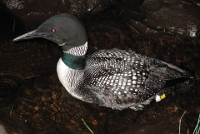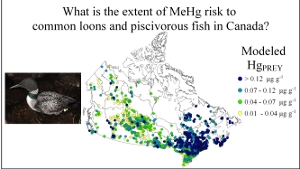Dynamic Environment & Ecosystem Health Research |
|
Home
People
Research & Opportunities
Historical gold mine tailings
Invasive & vulnerable species
Chinese mystery snails
Publications
Teaching
Resources & Links
Lab News
Click here to go back to Media & updates
Directions
With its wild cry and its prominent image on the dollar coin, the common loon is iconic to Canada. Yet, mercury contamination may be stressing our loon populations in the east. A new study co-authored by the Saint Mary’s professor indicates significant risk from mercury toxicity---not only to Canada’s iconic waterbird, but also to some varieties of sportfish.
Working as part of a university-government partnership, with funds from Environment Canada, and a Discovery Grant from the National Science and Engineering Research Council of Canada, Dr. Campbell and colleagues Dr. David Depew and Neil Burgess have analysed over 230,000 records of fish mercury from Canadian lakes and rivers to produce the first map of mercury concentrations for an entire country.
“Scientists around the world are working on this problem,” says Dr. Campbell, “and there were previous maps for mercury concentrations in fish, but they were restricted to individual states, regions and provinces.”
The value of a national map, according to Campbell, is that it demonstrates in a very clear way the variations in mercury concentrations across the country. “On our map,” she says, “an increase as you go from the west coast of Canada to the east raises an environmental red flag for the Atlantic provinces, our sport fish, and fish-eating birds like the common loon.”
Dr. Campbell explains that mercury levels in aquatic wildlife are determined by a variety of factors including long-range atmospheric transport of emissions, tree cover around lakes and rivers, local soil conditions, and general geography. Once in the water, mercury is moved along through the aquatic food web, eventually affecting the health, reproduction and survival of loons and other predators.
“Canada’s recent adoption of the Minamata Convention strengthens our commitment to limit mercury emissions worldwide,” says Dr. Campbell. “Our map will help to identify regions at risk and it has great potential for use by wildlife protection groups and Environment Canada.”
At the end of the day---this has to be good news for loons.
###
References & links to paper & supplementary materials:
David Depew, Neil M Burgess & Linda M Campbell. Spatial patterns of methylmercury risks to common loons and piscivorous fish in Canada. Environmental Science & Technology. DOI: 10.1021/es403534q
Link: http://pubs.acs.org/doi/abs/10.1021/es403534q
Supplementary materials: forthcoming.
Photographs & images (click for full resolution PDF and JPEG files):


Contacts:
Dr. Linda Campbell (Environmental Science, Saint Mary’s University)
Acknowledgements:
This research was funded by an Environment Canada Clean Air Regulatory Agenda (CARA) contract supplemented by an Natural Science & Engineering Research Council Discovery Grant to Dr. Linda Campbell. Dr. David Depew carried out the bulk of the work during his postdoctoral position.
Media mentions:
Ontario Out of Doors Magazine "Mercury impacts loons and fish." (April 2014) Link to jpeg of article. (This magazine goes to all Ontario Federation of Anglers and Hunters members)
Halifax Chronicle-Herald "Mercury risk worst for loons, fish in Eastern Canada, study finds" (November 3, 2013, Clare Mellor).
CBC Radio One Mainstreet Nova Scotia "Mercury and loons" (November 4, 2013, Stephanie Doucet). Rough transcription (PDF).
oceanbites blog "Top predators reveal the extent of mercury pollution in Canadian waters" (November 1, 2013, Samantha Decuollo) Link.

Resources
Click to
find:
- Images & photographs
- Link to publication
- Contacts
- Funding sources & acknowlegements
- Media mentions
- Images & photographs
- Link to publication
- Contacts
- Funding sources & acknowlegements
- Media mentions
All images and
content copyright (c)
Linda
Campbell and other members of Dynamic Environment & Ecosystem Health Research Group